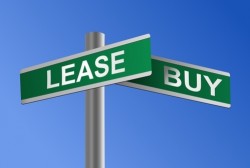What Makes The Most Sense When Buying Or Leasing Your Next Car?

By Paul Crosby, TestDriveNow.com
In today’s marketplace, there are three primary methods of purchasing a new car; paying cash, financing or leasing. Buying a vehicle for cash is the most straightforward method. The buyer and seller agree on a price, and the buyer provides cash or certified funds to the seller in order to obtain the vehicle with a clear title. The other two options, financing and leasing, are a bit more complex. While they both share some of the same characteristics, there are some unique differences between them.
• Financing. Automotive finance programs are incredibly complex instruments. A complete explanation of their inner workings is beyond the scope of this article, so let’s just touch on the key points. Financing a vehicle is simply a method of spreading out the cost of a vehicle over a specific period of time. It involves three primary components: your down payment, the value of your trade (if you decide to trade your current vehicle) and the time period of the loan. These three components combine to determine what the monthly payment will be for the vehicle. The key benefits of financing are flexibility in the payment terms and the fact that you will own the vehicle at the end of the financing term. Several auto companies now offer more attractive finance rates for returning customers through “owner loyalty” programs. These can provide significant savings if you choose to stay with the same brand when purchasing your next vehicle.
• Leasing. Leasing differs significantly from a traditional auto finance program. Most people think of leasing as renting the car for a long time, which is not far from the truth. Unlike a purchase, at the end of a lease term you do not own the vehicle. Leasing is generally only used on brand new vehicles; it does not make financial sense to lease a used car, normal finance programs work far better. When you lease a vehicle you are effectively paying for a portion of the total value of the vehicle for a pre-determined time period. Leasing usually does not require the same levels of an upfront expense as a traditional finance program. The down payment and monthly payments are usually far lower when comparing a lease to a finance program on the same vehicle. At the end of a lease term, a lessee has several options. You could extend the lease, do a new lease on a similar vehicle or purchase the car from the lease company. Most leases will have a predetermined buyout price for the vehicle at the conclusion of the lease. This price is usually lower than the current market value, and as such represents a good value if you decide to purchase the car.
There are several key points to keep in mind when deciding between financing and leasing. A potential buyer needs to decide how long they plan on staying with the same vehicle and what level of down payment they are prepared to come up with. Leasing allows you to have a more expensive vehicle with less money down and lower payments than a comparable finance of the same vehicle. Auto dealers will always provide multiple lease and finance options that clearly illustrate the components of each type. As always, do your research and check for special programs and incentives before you decide which is best for you.

